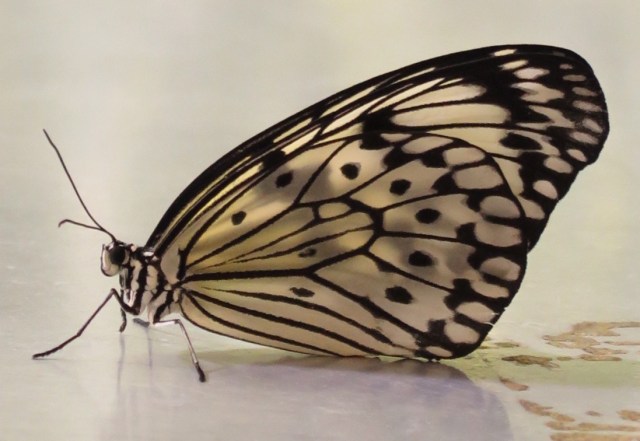Beauty is in the eye of the beholder, and as you will see in this week’s installment, the inhabitants of the American Museum of Natural History’s Butterfly Conservatory can look like gossamer damsels or monsters from a b-movie. Not only was this a great photographic opportunity, but also in some cases meeting some of these creatures provided moments to face my fears of flying insects (see this post for background). While some of the butterflies and moths were small and lovely, others…not so much.
Take a look at this sampling.
These lacy butterflies have many names – tree nymph, paper kite, rice paper, etc. They live in Malaysia and have a delicate fragility:
As airy (no pun intended) as the tree nymphs are they can’t hold a candle to the glass wing – you can literally see a candle through this butterfly’s transparent wings:
Next we have the Great Mormon (or Great Memnon) Papilio, a stunning and large butterfly with a wing span of up to 6 inches. This butterfly’s natural habitat runs from the Indonesian to Australian ecological zones. The basic colour of Papilio is black, but there are also spectacularly colored ones with stripes and pink splotches.
Even a tree nymph was attracted to the pretty Great Memnon. In general butterflies appear to live in harmony, although the males are territorial and may push others off the best perches on the foliage.
These butterflies are fairly large, but none triggered my entophobia until I literally almost ran into this fellow. I think it is called a polydames swallowtail and as I got closer I saw how thick and furry his body was. I felt a stirring of an impending panic attack. However. the love of photography won out – that and the fact that these creatures do NOT bite or sting:
I was fascinated by the way the proboscis stays all curled up until it is extended to drink nectar from a flower, a dish of sugar-water or juice from an orange.
My fear was further tested by this next creature , a luna moth with a wingspan of up to 7 inches. It’s a lovely spring green, but its body is a bit disconcerting:
Almost looks like a mini-bat.
I would have met my Waterloo with this next moth, but for the fact that it was – for ITS safety – in a mesh enclosure. It is an Atlas moth and it is huge – the largest species of moth in the world with a wingspan about 12 inches across. Despite its size, it doesn’t eat anything after it hatches from its cocoon as it doesn’t have a fully formed mouth. As such it lives off the stored energy it acquired as a caterpillar and soon perishes.
The Cantonese name for the moth means “snake’s head moth,” referring to the outer tips of the wings that look very similar to the head of a snake. That’s sure to scare away most predators:
Circling back to the title of this post – despite the enclosure the face of the Atlas moth gave me the shivers:
I’m sleeping with the windows closed and the lights on tonight.
#



















These pictures are magnificent. Not only are you a beautiful writer but you are also a terrific photographer. You are so talented.
Thanks so much, Manya! – I love having this forum to share my photos and musings – and it is so gratifying that people enjoy it! Hope all is well – love!